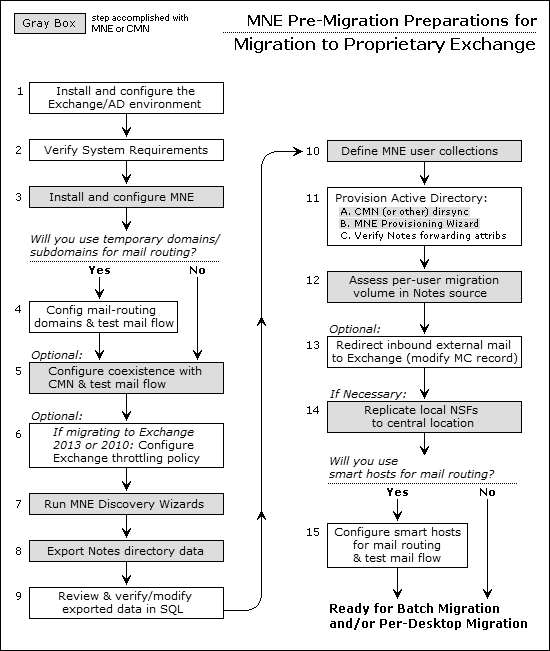Migration to a proprietary Exchange target
For our purposes, a proprietary Exchange environment is one whose hardware and software are wholly under the control of the migrating organization. A proprietary Exchange server typically is on the same premises as the Notes source, but could reside elsewhere.
|
NOTE: A mail-enabled Active Directory object is one with a mail-address attribute for an address outside the Exchange domain, so AD can forward the object’s mail to its external address. A mailbox-enabled object is one that has an Exchange mailbox. An AD object that is mail-enabled cannot receive mail in Exchange unless it is also mailbox-enabled; a mail-enabled AD object without a mailbox can only forward mail to an object’s external forwarding address. |
Pre-migration preparations
|
Conditional Step: Steps that apply only in particular circumstances are clearly marked with this "If" branching-arrows icon and a note explaining when the step applies. |
|
NOTE: This process does not create users’ Exchange mailboxes until just prior to their migration (per user collection, in the Batch migration process), due to the Exchange free/busy limitation (explained in chapter 1, see the Important note under Provisioning and mailbox creation for Office 365. If you will not configure free/busy coexistence, you could create Exchange mailboxes earlier in the process, in these Pre-Migration Preparations, as long as you also set Exchange-to-Notes mail forwarding for not-yet-migrated Notes users. |
Step 1: Install and configure your target Exchange environment
Step 2: Verify all system requirements are satisfied
All system requirements must be satisfied before you install Migrator for Notes to Exchange in the next step below. System Requirements are documented in the most recent RTM Release Notes. The admin accounts that will be used to run the Quest applications and access data and features in the Notes/Domino and Exchange/AD environments also will require particular permissions, as specified in Migrator for Notes to Exchange’s Pre-Migration Planning Guide (see the topic Configuration requirements and account permissions). If these accounts do not already exist, create and configure them now.

